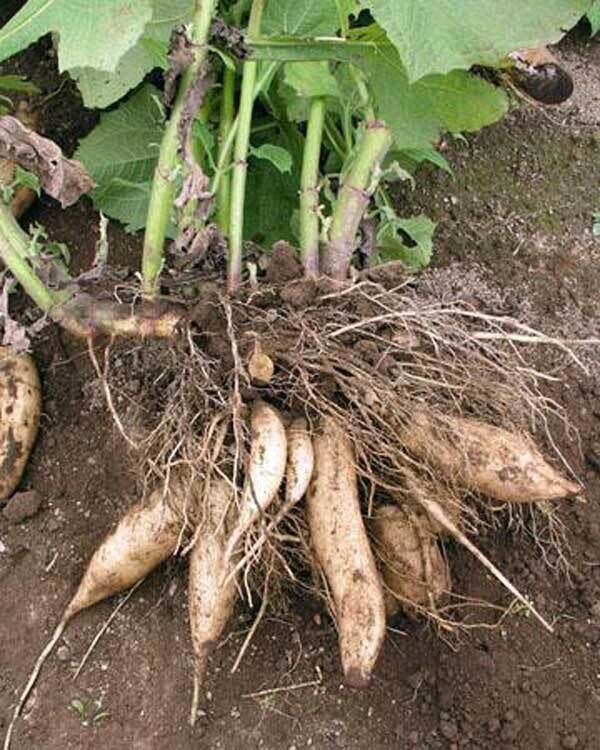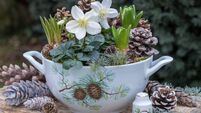The potatoe is easy to grow once you take good care

March is the month of tuber planting, from potatoes to Jerusalem artichokes to yacon — and while most tubers stuck in any well-drained, humus-loaded soil will take and perform, there can be a little trouble ahead.
Here’s how to head that off at the pass, or at least to recognise the trouble and take steps to avoid next time.
Pretty much all of the following has happened to me over my growing lifetime – there is no novice’s mistake that doesn’t befall even the most well-seasoned grower.
Never be deterred by a setback.
No show/ fresh foliage fails to emerge.
More than likely you planted too early and frost killed your tuber or you planted into too wet a soil and root rot occurred.
You may have gotten a bad batch of seed (fungal infected or diseased – only plant firm healthy-looking seed stock), and it was already terminal before you got it into the ground.
Wireworms and other nematodes may have wreaked havoc before the tuber got a chance to get active. Wireworms over-winter not far from soil surface so a dig over in early Feb exposes them to feeding birds.

They like it cool and will sink deeper as the days get warmer (if you planted too early you just dropped your crop in their lap) – you can apply beneficial nematodes (most garden centres stock them in a sachet form) that will seek and destroy tuber pests but will not touch your-soon-to-be-planted tubers.
I plant a few seed potatoes early each year and dig them up a week before I plan to bulk plant, slice them in half, (but you can do a full on autopsy to check for any nematode damage), and if none are present then I plant without applying pest-management solutions.
Failing any of the above — you may have rodents who’ll thank you for a meal.
I use black pepper and chili flakes to keep feral (really the neighbour’s) cats off any tilled beds and I know some organic growers who plant tubers with a dusting of the same deterrent.
Some foliage emerges but dies off just as quick
Are you planting before all frost has passed? Is a roll of fleece worth the investment? Have you planted in a spot that gets to much wind or sun?— both can scorch off new growth.
Dieback is generally a fungal/bacterial infection in the soil rather than in the seed stock.
With seeds sown into seed trays you can use chamomile tea (hot or cold) or boiling water to sterilise the growing media— with a raised bed or plot that’s not so viable (time and resources wise, unless you have an acre of chamomile and a solar kettle).
You can hold back some tubers to start them in sterilized conditions in a 2lt pot and plant out later in April or May — this I do with any expensive Peruvian tuber crops, (yacon), many of which are best treated like dahlia, but more on that next week.
Plants emerge but disappear without sign of dieback
Pesky wabbits or other boxy browsers — you could get your Elmer Fudd on and chase them off or do a Donald Trump and build a wall — well a fence at least.
A sleeper style raised bed is a fortress, especially when you can cage the top with chicken wire. It may be a case of cutworms or other grubs— garlic spray is a great deterrent and a toxin to munching pests but harmless to humans. All that said, it is probably just the perennial pest. the old foe slug/snail.
Speaking of old foe – a little over a hundred years ago there was a monthly woman’s magazine called Bean Na hÉireann published by Inghínidhe Na hÉireann — The daughters of Ireland and was produced by Maude Gonne, Kathleen Lynn and Helena Molony with the aim of prompting political debate and activism on universal suffrage, anti-imperialism and Irish self-determination.
Of course there was a gardening column and the advice within on slugs was to kill them on sight. The suggestion was made that if you were anyway reticent or squeamish about the grim task, to just think of them as British soldiers. I still laugh at the thought of it.

The best way to kill slug/snails is by beer traps and nematodes while the better deterrents are grit, egg shells and sprinkled wood ash.
If I can crowbar in a line from the proclamation — when you are going after slugs do it “in full confidence of victory”.
Emerged leaves turn yellow
oo much tap water can cause a magnesium imbalance in plants that inhibits how they make chlorophyll (the green pigment and energy centre of photosynthesis) – a little Epsom salts in the watering can will rectify that.
Leaves becoming yellow and then brown from the bottom up are an indication of wireworms.
Leaves that turn yellow and curl is indicative of insect damage and a garlic spray or organic insecticide is called for.
Feed your plant well after that, just as you might take a prebiotic after an antibiotic.
In many cases the culprits are aphids who suck the nutrients and sap from the foliage and so aid in depletion and discolouration.
You can jet wash them off with the hose but some sudsy water is good to smother the clingers-on and to wash away any secretions of honeydew which promotes black sooty mould.
Aphids can transmit viruses into plants so treat them worse than British soldiers. If you’re growing edible dahlia, yacon or oca in a greenhouse or polytunnel, then it could be spider mit — mist foliage to disrupt their dry atmosphere colonisation.
Mottled and/or crinkled foliage
A sure sign of mosaic virus transmitted by aphids. There are resistant varieties of most tubers on the market, but tackling aphids early is sound advice.
Plant some companion plants to encourage ladybirds and lacewings to decimate aphid populations long before you have even noticed the problem.
n Stunted foliage growth and eventually low yield means not enough nutrition in soil or too much or too little water.
n Stunted growth with yellowish-black streaks inside stems is a classic sign of fusarium wilt — a soil fungus, often showing a lack of crop rotation. It can be removed by solarisations (covering soil with clear plastic for a month or two to cook it out over summer.
Base of stems becomes slimy and dark brown or black
It’s blight or other fungal infection. Soon the tubers will rot too. Preventative spraying is the norm. Look for blight warning on the weather.
The definitive potato blight appears like water spots but irregular, greyish brown, stems turning slimy and total collapse. The lifted tubers may have some
brown-purple surface scars and they will rot in storage. There are blight resistant varieties of potato and other edible tubers.
Lush foliage but little or no harvest beneath
This is the tell-tale sign of poor watering – spraying the foliage but not drenching the roots.
Tubers tend to swell better in lower temperatures, so if the summer is unseasonably warm, especially at night, the yield will be low. Small sized tubers is down to watering too little, poor soil nutrition and occasional heat (too much of it).
A knobby harvest
If it’s not how it’s meant to look or is scabbed with corky spots, then it can be that your soil is too alkaline and a little sulphur worked into next year’s location will sort that out, or it can be a sign of a bacterial or fungal disease – pH changes can also remedy that.
Cavities in harvested tubers can be caused by verticillium fungus or be a result of munching grubs. Rotten tubers can be due to over- watering or where a fork on a previous lift damaged the tuber tissue and it got diseased.
Tubers that rot or shrivel in storage are carrying a bacterial infection or have been compromised by the storage method. Tubers that don’t taste nice – try a little salt and skip next year. Grow what you eat and you won’t go hungry.
Next week Peruvian crops that might excite your taste buds and extend your growing season.












